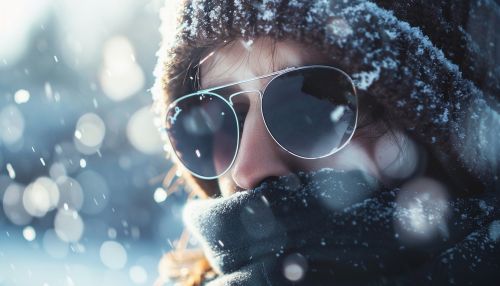Photokeratitis
Introduction
Photokeratitis, also known as ultraviolet keratitis or snow blindness, is an acute condition resulting from the overexposure of the cornea and conjunctiva to ultraviolet (UV) radiation. This condition is akin to a sunburn of the eyes and can be caused by natural sources such as sunlight reflected off snow, water, or sand, as well as artificial sources like welding arcs and tanning lamps. The condition is characterized by pain, redness, tearing, and temporary vision impairment.
Etiology and Pathophysiology
Photokeratitis occurs when the corneal epithelium absorbs excessive UV radiation, leading to cellular damage and an inflammatory response. The primary wavelengths responsible for this damage are UV-B (280-315 nm) and UV-C (100-280 nm). UV-A (315-400 nm) is less harmful but can still contribute to the condition under prolonged exposure.
The corneal epithelium, which is the outermost layer of the cornea, contains chromophores that absorb UV radiation. This absorption leads to the formation of reactive oxygen species (ROS), which can cause cellular apoptosis and necrosis. The resulting damage triggers an inflammatory response, characterized by the release of cytokines and other inflammatory mediators, leading to the symptoms of photokeratitis.
Clinical Presentation
The symptoms of photokeratitis typically manifest within a few hours of exposure and can include:
- Severe eye pain
- Redness and swelling of the conjunctiva
- Excessive tearing
- Photophobia (sensitivity to light)
- Blurred vision
- Foreign body sensation in the eyes
In severe cases, patients may experience temporary vision loss, which usually resolves within 24 to 48 hours.
Diagnosis
Diagnosis of photokeratitis is primarily clinical, based on the patient's history of UV exposure and the characteristic symptoms. A slit-lamp examination may reveal punctate epithelial erosions on the cornea, which are indicative of UV-induced damage. Fluorescein staining can be used to highlight these erosions, which appear as small, bright spots under blue light.
Treatment
Treatment for photokeratitis is largely supportive and aimed at alleviating symptoms. Recommended measures include:
- Resting the eyes in a darkened environment to reduce photophobia
- Using cold compresses to alleviate pain and swelling
- Administering lubricating eye drops or ointments to soothe the cornea
- Prescribing oral analgesics for pain management
In cases of severe pain, topical anesthetics may be used, but their use should be limited to avoid further damage to the corneal epithelium. Antibiotic eye drops may be prescribed to prevent secondary infections, although the risk is generally low.
Prevention
Preventing photokeratitis involves minimizing UV exposure to the eyes. This can be achieved by:
- Wearing sunglasses with UV protection
- Using wide-brimmed hats to shield the eyes from direct sunlight
- Employing protective eyewear, such as welding helmets or goggles, when working with artificial UV sources
Prognosis
The prognosis for photokeratitis is generally excellent, with most cases resolving within 24 to 48 hours without long-term sequelae. However, repeated episodes of UV exposure can lead to chronic conditions such as pterygium, pinguecula, and cataracts.
Epidemiology
Photokeratitis is more common in environments with high UV exposure, such as snowy, sandy, or high-altitude regions. It is also prevalent among individuals who engage in outdoor activities like skiing, snowboarding, and water sports, as well as those who work with artificial UV sources, such as welders and tanning salon employees.
Research and Future Directions
Ongoing research in the field of photokeratitis focuses on understanding the molecular mechanisms underlying UV-induced corneal damage and developing more effective preventive and therapeutic strategies. Advances in protective eyewear technology and the development of pharmacological agents that can mitigate UV-induced damage are areas of active investigation.
See Also


